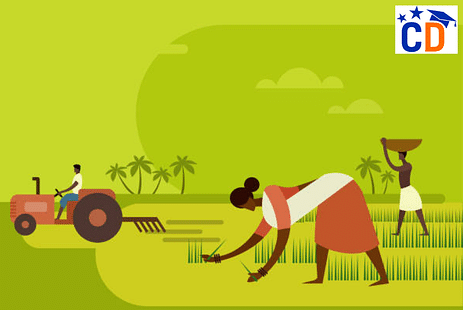
CUET 2025 Agriculture Syllabus: CUET 2025 Agriculture Syllabus has been released by the NTA on its official website- exams.nta.ac.in. The CUET Agriculture Syllabus 2025 includes four units: Unit 1 Agrometeorology, Genetics and Plant Breeding, Biochemistry and Microbiology, Unit 2 Livestock Production, Unit 3 Crop Production, and Unit 4 Horticulture. Candidates can check the CUET Agriculture Syllabus pdf and download it from here.
CUET Agriculture Syllabus 2025 PDF - Click Here to Download |
|---|
The Agriculture Exam is part of Section II and covers topics such as crop production, horticulture, and livestock farming. Understanding the CUET 2025 Agriculture Syllabus will assist aspiring candidates in preparing for the exam and increasing their chances of admission to their preferred CUET-participating college or university. In addition to the syllabus, students can practise previous years' question papers to help them prepare for the examination. Candidates interested in applying for CUET 2025 must go over the Agriculture Syllabus to prepare thoroughly.
The
CUET UG 2025
entrance exam is administered by the National Testing Agency. Through CUET, candidates are given the opportunity to apply for undergraduate programs at central, private, deemed, and state universities in India. The CUET 2025 exam will be held from May 8 to June 1, 2025.
Also Read:
CUET Syllabus 2025
CUET Agriculture Exam Pattern 2025
Candidates appearing for CUET Agriculture exam must go through the CUET Agriculture exam pattern listed below.
Particulars | Details |
|---|---|
CUET Exam Conduction Body | National Testing Agency |
Mode of the examination | Computer-based test mode |
Language of exam | 13 languages - English, Hindi, Assamese, Bengali, Gujarati, Kannada, Malayalam, Marathi, Odia, Punjabi, Tamil, Telugu, and Urdu |
Type of questions | Multiple Choice Questions (MCQs) |
Total number of Questions | 50 questions |
Duration of Exam | 45 minutes |
Negative marking | Yes |
Marking Scheme | +5 for each correct answer -1 for each incorrect answer |
CUET Agriculture Mapping for Courses |
B.A. in Agriculture
|
CUET Agriculture Unit-wise Syllabus
Candidates will be given a total of 50 questions in the Agriculture CUET exam, of which 40 must be attempted. They will have forty-five minutes to figure out the answers to the questions. To be admitted to the Agriculture program, applicants must carefully review the syllabus available here before taking the CUET UG 2025 exam.
Unit 1: Agrometeorology, Genetics and Plant Breeding, Biochemistry and Microbiology
Agrometeorology: Weather-related factors: precipitation, temperature, humidity, wind speed, sunshine forecasting, and the impact of climate change on crop productivity.
Genetics & Plant Breeding:
- The structure of the cell, the meaning of mitosis and meiosis in cell division,
- The arrangement of the genetic components in DNA, RNA, and chromosomes
- The inheritance laws of Mendel. explanations for Mendel's experiments' success. Linkage was absent in Mendel's tests.
- In plants, there are two types of variation: continuous and discontinuous.
- Inheritance that is polygenic and monogenic.
- The function of genetics in plant breeding, including self- and cross-pollinated crops, introduction, hybridisation, selection, polyploidy, mutation, and tissue and cell culture techniques.
- The definition and application of plant biotechnology in crop production
Biochemistry:
pH and buffers; classification and nomenclature of carbohydrates, proteins, lipids, vitamins, and enzymes.
Microbiology:
Focuses on the structure of microbial cells, including those found in algae, bacteria, fungi, actinomycetes, protozoa, and viruses. Role of micro-organisms in respiration, fermentation, and organic matter decomposition; Soil flora and fauna.
Seed Science:
Seed structure of monocots and dicots, mode of reproduction, pollination, fertilization, Seed dormancy, types of seeds.
Unit 2: Livestock Production
Scope and Importance:
- Livestock's importance in agriculture and industry, as seen during India's white revolution.
- Important Indian and exotic breeds, including the distribution of cows, buffaloes, and poultry in India.
Care and Management:
- Housing systems for cattle and poultry
- principles and practices related to feeding. Definition and ingredients of a balanced ration.
- Calves, bullocks, pregnant and lactating animals, chicks, cockerels, layers, and poultry are all managed.
- Signs of illness in animals, symptoms of common diseases in cattle and poultry, including rinderpest, black quarter, foot and mouth, mastitis, haemorrhagic septicaemia, coccidiosis, fowl pox, and Ranikhet disease, as well as prevention and control.
Livestock Products: The processing and marketing of milk and dairy products.
Fisheries: Definition of fish, fisheries, aquaculture; General characteristics of fish, types of fishes.
Unit 3: Crop Production
Introduction:
- Targets and achievements in foodgrain production in India since independence, as well as future projections for sustainable crop production, commercialisation of agriculture, and its scope in India.
- Field crops are classified according to their utility: cereals, pulses, oil seeds, fibre, sugar, and forage crops.
- Soil, soil pH, Soil texture, soil structure, soil organisms, soil tilth, soil fertility, and soil health.
- Essential plant nutrients, their functions, and deficiency symptoms.
- Soil types of India and their characteristics.
- Organic manure, common fertilizers including straight, complex, fertilizer mixtures and biofertilizers; integrated nutrient management system.
- Problem soils, soil erosion, soil pollution.
- Soil analysis for nutrient availability.
Irrigation and Drainage:
- Sources of irrigation (rain, canals, tanks, rivers, wells, tubewells).
- Scheduling of irrigation based on critical stages of growth, time interval, soil moisture content, and weather parameters.
- Water requirement of crops.
- Methods of irrigation and drainage.
- Watershed management.
- Irrigation water quality.
Crops:
Seedbed preparation, seed treatment, time and method of sowing/planting, seed rate; dose, method, and time of fertilizer application, irrigation, intercultural and weed control; common pests and diseases, caused by bacteria, fungi viruses, and nematode and their control, integrated pest management, harvesting, threshing, post-harvest technology: storage, processing, and marketing of major field crops-Rice, wheat, maize, sorghum, pearl millet, groundnut, mustard, pigeon-pea, gram, sugarcane, cotton, and berseem; Millets and their importance.
Modern agriculture:
Challenges in modern agriculture; conservation agriculture; precision agriculture; natural farming; organic farming; remote sensing in agriculture.
Unit 4: Horticulture
- Importance of fruits and vegetables in the human diet
- Crop diversification & processing Industry.
- Orchard- location and layout, ornamental gardening, and kitchen garden.
- Planting system, training, pruning, intercropping, protection from frost and sunburn.
- Trees, shrubs, climbers, annuals, perennials-definition and examples.
- Propagation by seed, cutting, budding, layering, and grafting.
-
Cultivation practices, processing, and marketing of:
- Fruits - mango, papaya, banana, guava, citrus, grapes.
- Vegetables - Radish, carrot, potato, onion, cauliflower, brinjal, tomato, spinach, and cabbage.
- Flowers - Gladiolus, canna, chrysanthemums, roses and marigold.
- Principles and methods of fruit and vegetable preservation.
- Preparation of jellies, jams, ketchup, chips and their packing.
Also Read: CUET Courses List 2025
CUET Agriculture Syllabus 2025 Weightage
Candidates should begin their preparation according to the CUET Agriculture Syllabus 2025 chapter-by-chapter weighting. The majority of questions in agriculture come from the fields of microbiology, biochemistry, genetics and plant breeding, and meteorology. The table below shows the chapter-by-chapter weighting of the CUET Agriculture Syllabus 2025 for candidates.
CUET Agriculture Syllabus 2025 Weightage | |
|---|---|
Units | Expected Number of Questions |
Unit 1: Agrometeorology, Genetics and Plant Breeding, Biochemistry and Microbiology | 8-10 |
Unit 2: Livestock Production | 5-6 |
Unit 3: Crop Production | 5-6 |
Unit 4: Horticulture | 7-8 |
CUET Agriculture Important Topics
Candidates can check the important topics for CUET Agriculture from the below table.
| Topics | Important Topics |
|---|---|
| Agronomy |
|
| Soil Science |
|
| Horticulture |
|
| Plant Physiology & Genetics |
|
| Animal Husbandry & Fisheries |
|
| Agricultural Economics & Extension |
|
| Agricultural Engineering |
|
Best Books for CUET Agriculture Preparation
It is necessary to have a thorough understanding of various agricultural concepts and practices in order to prepare for the CUET Agriculture exam. Your level of preparation can be greatly impacted by your choice of study materials. The best CUET Agriculture books offer practice questions, past years' papers and in-depth explanations to aid students in understanding difficult subjects in addition to covering the entire syllabus. The list of suggested books that can help you prepare for the CUET Agriculture exam is provided below:
- ICAR AIEEA UG (Popular Master Guide) by R. Gupta’s
- Class XII NCERT Agriculture Textbook
- Competitive Agriculture by Nem Raj Sunda
- Fundamentals of Agriculture by Arun Katyayan
- A Complete Guide of Agriculture by Bhani Ram Dall, Mamta Dall
- Principles of Agronomy by Reddy & Reddy
- Introduction to Agriculture by A.K. Vyas
- Agricultural Economics by Subba Reddy
- Objective Agriculture Science by SR Das
- Agriculture at a Glance by R.K. Sharma
- Objective Agriculture by S.R. Kantwa
Also Read: CUET Preparation Tips 2025
CUET Agriculture Preparation Tips 2025
For the CUET UG 2025 exam, candidates must adhere to a proper preparation plan in order to receive good scores. To get ready for the CUET UG exam, they can adhere to the preparation advice listed below.
- Know the Syllabus: Get an understanding of the syllabus and know exactly what topics you need to study. This will assist you in concentrating on what's important.
- Create a Study Schedule: Make a study schedule that allocates your study time to the various subjects. To make sure you cover everything, adhere to it.
- Make Use of Quality Study Resources: Look for trustworthy agricultural textbooks and internet resources. They should thoroughly cover your syllabus and be current.
- Practice Exam Papers: Complete past exam papers get an understanding of the questions that are asked and their format.
- Make a note of it: Make notes of key terms, definitions, and concepts as you study. Before the test, these notes will be helpful for brief reviews.
- Participate in Study Groups: Studying with others can help you stay motivated and make sense of complex concepts. Together, you can solve problems and discuss various subjects.
- Keep Up with: Remain up to date on the latest advancements and trends in agriculture. This could be useful in providing answers to enquiries about current developments.
- Self-care: Remember to get enough sleep, eat a healthy diet, and take breaks. You can study more effectively and do well on the test if your body and mind are in good health.
So, this was all about the CUET 2025 Agriculture Syllabus. For more such information, latest updates and news/articles related to CUET 2025, stay tuned to CollegeDekho !
Are you feeling lost and unsure about what career path to take after completing 12th standard?
Say goodbye to confusion and hello to a bright future!

CUET Previous Year Question Paper
Was this article helpful?



















Similar Articles
College of Agricultural Engineering, Raichur KCET Expected Cutoff 2025 with Previous Years' Cutoff Trends
College of Agricultural Engineering, Bangalore KCET Expected Cutoff 2025 with Previous Years' Cutoff Trends
College of Horticulture, Almela KCET Expected Cutoff 2025 with Previous Years' Cutoff Trends
AP EAPCET (EAMCET) Agriculture 2025: Application Form (Released), Exam Dates (May 19 to 20), Syllabus, Result, Counselling, Latest Updates
List of Colleges Accepting TS EAMCET Agriculture Score 2025
What after TS EAMCET Agriculture?